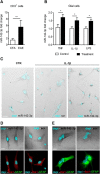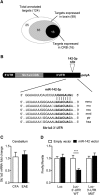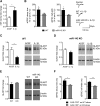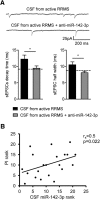miR-142-3p Is a Key Regulator of IL-1β-Dependent Synaptopathy in Neuroinflammation
- PMID: 28100738
- PMCID: PMC6596761
- DOI: 10.1523/JNEUROSCI.0851-16.2016
miR-142-3p Is a Key Regulator of IL-1β-Dependent Synaptopathy in Neuroinflammation
Abstract
MicroRNAs (miRNA) play an important role in post-transcriptional gene regulation of several physiological and pathological processes. In multiple sclerosis (MS), a chronic inflammatory and degenerative disease of the CNS, and in its mouse model, the experimental autoimmune encephalomyelitis (EAE), miRNA dysregulation has been mainly related to immune system dysfunction and white matter (WM) pathology. However, little is known about their role in gray matter pathology. Here, we explored miRNA involvement in the inflammation-driven alterations of synaptic structure and function, collectively known as synaptopathy, a neuropathological process contributing to excitotoxic neurodegeneration in MS/EAE. Particularly, we observed that miR-142-3p is increased in the CSF of patients with active MS and in EAE brains. We propose miR-142-3p as a molecular mediator of the IL-1β-dependent downregulation of the glial glutamate-aspartate transporter (GLAST), which causes an enhancement of the glutamatergic transmission in the EAE cerebellum. The synaptic abnormalities mediated by IL-1β and the clinical and neuropathological manifestations of EAE disappeared in miR-142 knock-out mice. Furthermore, we observed that in vivo miR-142-3p inhibition, either by a preventive and local treatment or by a therapeutic and systemic strategy, abolished IL-1β- and GLAST-dependent synaptopathy in EAE wild-type mice. Consistently, miR-142-3p was responsible for the glutamatergic synaptic alterations caused by CSF of patients with MS, and CSF levels of miR-142-3p correlated with prospective MS disease progression. Our findings highlight miR-142-3p as key molecular player in IL-1β-mediated synaptic dysfunction, possibly leading to excitotoxic damage in both EAE and MS diseases. Inhibition of miR-142-3p could be neuroprotective in MS.
Significance statement: Current studies suggest the role of glutamate excitotoxicity in the development and progression of multiple sclerosis (MS) and of its mouse model experimental autoimmune encephalomyelitis (EAE). The molecular mechanisms linking inflammation and synaptic alterations in MS/EAE are still unknown. Here, we identified miR-142-3p as a determinant molecular actor in inflammation-dependent synaptopathy typical of both MS and EAE. miR-142-3p was upregulated in the CSF of MS patients and in EAE cerebellum. Inhibition of miR-142-3p, locally in EAE brain and in a MS chimeric ex vivo model, recovered glutamatergic synaptic enhancement typical of EAE/MS. We proved that miR-142-3p promoted the IL-1β-dependent glutamate dysfunction by targeting glutamate-aspartate transporter (GLAST), a crucial glial transporter involved in glutamate homeostasis. Finally, we suggest miR-142-3p as a negative prognostic factor in patients with relapsing-remitting multiple sclerosis.
Keywords: CSF; experimental autoimmune encephalomyelitis; glial glutamate transporter; glutamate excitotoxicity; microRNA; multiple sclerosis.
Copyright © 2017 the authors 0270-6474/17/370547-16$15.00/0.
Figures









Similar articles
-
MiR-142-3p regulates synaptopathy-driven disease progression in multiple sclerosis.Neuropathol Appl Neurobiol. 2022 Feb;48(2):e12765. doi: 10.1111/nan.12765. Epub 2021 Oct 6. Neuropathol Appl Neurobiol. 2022. PMID: 34490928 Free PMC article.
-
MiR-409-3p and MiR-1896 co-operatively participate in IL-17-induced inflammatory cytokine production in astrocytes and pathogenesis of EAE mice via targeting SOCS3/STAT3 signaling.Glia. 2019 Jan;67(1):101-112. doi: 10.1002/glia.23530. Epub 2018 Oct 7. Glia. 2019. PMID: 30294880
-
IL-1β dependent cerebellar synaptopathy in a mouse mode of multiple sclerosis.Cerebellum. 2015 Feb;14(1):19-22. doi: 10.1007/s12311-014-0613-0. Cerebellum. 2015. PMID: 25326653 Review.
-
Interleukin-1β alters glutamate transmission at purkinje cell synapses in a mouse model of multiple sclerosis.J Neurosci. 2013 Jul 17;33(29):12105-21. doi: 10.1523/JNEUROSCI.5369-12.2013. J Neurosci. 2013. PMID: 23864696 Free PMC article.
-
Glutamate, T cells and multiple sclerosis.J Neural Transm (Vienna). 2017 Jul;124(7):775-798. doi: 10.1007/s00702-016-1661-z. Epub 2017 Feb 24. J Neural Transm (Vienna). 2017. PMID: 28236206 Review.
Cited by
-
Interplay Between Age and Neuroinflammation in Multiple Sclerosis: Effects on Motor and Cognitive Functions.Front Aging Neurosci. 2018 Aug 8;10:238. doi: 10.3389/fnagi.2018.00238. eCollection 2018. Front Aging Neurosci. 2018. PMID: 30135651 Free PMC article. Review.
-
Synaptic Dysfunction in Multiple Sclerosis: A Red Thread from Inflammation to Network Disconnection.Int J Mol Sci. 2021 Sep 9;22(18):9753. doi: 10.3390/ijms22189753. Int J Mol Sci. 2021. PMID: 34575917 Free PMC article. Review.
-
MiR338-3p expression in extracellular vesicles after severe trauma with or without traumatic brain injury.Brain Commun. 2025 Jun 21;7(4):fcaf242. doi: 10.1093/braincomms/fcaf242. eCollection 2025. Brain Commun. 2025. PMID: 40666703 Free PMC article.
-
Neuroinflammatory Nexus of Pediatric Epilepsy.J Pediatr Epilepsy. 2018 Jun;7(2):32-39. doi: 10.1055/s-0038-1668601. Epub 2018 Sep 3. J Pediatr Epilepsy. 2018. PMID: 31709125 Free PMC article.
-
miRNAs in Microglia: Important Players in Multiple Sclerosis Pathology.ASN Neuro. 2021 Jan-Dec;13:1759091420981182. doi: 10.1177/1759091420981182. ASN Neuro. 2021. PMID: 33517686 Free PMC article. Review.
References
-
- Ahlbrecht J, Martino F, Pul R, Skripuletz T, Sühs KW, Schauerte C, Yildiz Ö, Trebst C, Tasto L, Thum S, Pfanne A, Roesler R, Lauda F, Hecker M, Zettl UK, Tumani H, Thum T, Stangel M. Deregulation of microRNA-181c in cerebrospinal fluid of patients with clinically isolated syndrome is associated with early conversion to relapsing-remitting multiple sclerosis. Mult Scler. 2016;22:1202–1214. doi: 10.1177/1352458515613641. - DOI - PubMed
-
- Antonucci F, Turola E, Riganti L, Caleo M, Gabrielli M, Perrotta C, Novellino L, Clementi E, Giussani P, Viani P, Matteoli M, Verderio C. Microvesicles released from microglia stimulate synaptic activity via enhanced sphingolipid metabolism. EMBO J. 2012;31:1231–1240. doi: 10.1038/emboj.2011.489. - DOI - PMC - PubMed
Publication types
MeSH terms
Substances
LinkOut - more resources
Full Text Sources
Other Literature Sources
Medical
Molecular Biology Databases
